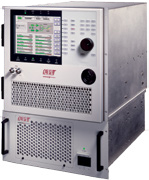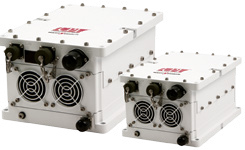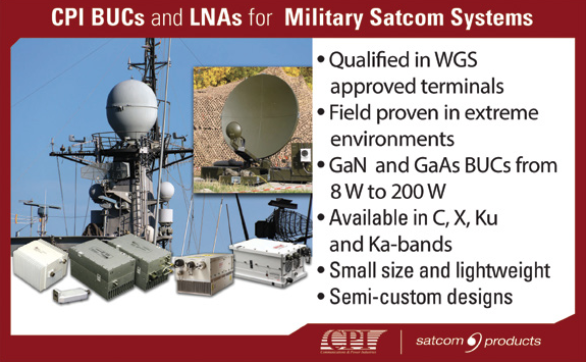Over the past several years, Communications & Power Industries LLC (CPI) has manufactured many products for use in Beyond Line of Sight (BLOS) and Communications on the Move (COTM) applications.

CPI GEN IV KPA
In this article, the amplifier requirements for which system integrators have asked and the innovative products that CPI has provided in response will be discussed.
Troposcatter / Beyond Line Of Sight (BLOS)
Troposcatter (also known as “Tropo” or BLOS) has become an increasingly popular mode of communication over relatively short distances due to certain advantages the technology has versus satellite links. Troposcatter links are secure, have no ongoing transponder cost and, with modern modem technology, can support high data rates. Troposcatter links typically vary from 50 miles to 200 miles in length.
Much work has been done in recent years in Ku-band at 15GHz, which is ideal for providing up to 40MBits at distances of 50 to 100 miles. While rain fade has occasionally been a negative factor in Ku-band satellite uplinks, a 1990 Dartmouth College study for the United States Air Force found that rain actually aids the signal in troposcatter communications by increasing the signal to noise ratio. The study was replicated by a commercial integrator at a variety of sites, setting off a stream of system development in this frequency band.
CPI has worked with leading U.S. prime integrators to demonstrate mobile systems using both 750W and 250W Ku-band SuperLinear® Traveling Wave Tube (TWT) amplifiers, which are demonstrably more efficient and lighter in weight than alternative types of amplifiers. These high power amplifiers (HPAs) have been tested and have performed successfully in severe environments, including desert, high altitude and high temperature. Transit case, rackmount and trailer mounted systems have been deployed in the United States and overseas. Systems in Asia and the Middle East also employ CPI amplifiers.
As with many satellite uplink applications, prime power to output power efficiency is crucial for troposcatter systems, as many of these systems are designed for mobile or remote deployment. The ratio of prime power to output power efficiency is stated as a percentage using the formula [Linear RF power (kilowatts) / Prime Power (kVA)].
For longer links, C-band is preferred by most operators. CPI has a GEN IV klystron power amplifier (KPA) that has demonstrated superior reliability and efficiency to legacy klystron systems, some of which are still in use. While previous systems consumed more than 10kW of prime power per amplifier, the multi-stage depressed collector (MSDC) technology used in the CPI GEN IV draws less than half this amount. This lower power consumption also lowers the temperature of the components, including the klystron, enabling more than 100,000 hours MTBF in the field. A separate independent study produced for the US Army showed that the GEN IV is the best alternative among TWTs, solid state power amplifiers (SSPAs) and KPAs for upgrading certain legacy tropo systems.
Even longer troposcatter links are possible using S-band systems with high power amplifiers. A 2GHz system is being evaluated using a 2.5kW GEN IV amplifier at high data rates. Multiple amplifiers can be combined to provide 5 or 10 kW for extreme link distances, which do come into play in some networks.
Solid State HPAs using Gallium Nitride (GaN) semiconductors in C-band with output powers of 500 to 1000 Watts and above are now in development at CPI. GaN provides superior efficiency due to the high-band gap properties of this material compared to older Gallium Arsenide (GaAs) devices.
The GaAs amplifiers, both corporate and spatially combined, have an efficiency of only about 7 percent when operating at linear output power, far less than mature MSDC TWT-based HPAs. The newer GaN devices show promise of efficiencies at linear power almost double that of GaAs devices, which will enable the next generation of solid state products to match the efficiencies of linearized TWTs up to about 300W.
Above that, klystrons and TWTs will still hold an advantage in power consumption, size and weight. Furthermore, GaN devices will only be competitive in cost (as measured by $/W) up to perhaps 1000W, due to the high cost of these products.
As the cost of GaN comes down with time, this threshold will change. However, for the next number of years GaN will mostly displace other GaAs products and applications rather than tube-based amplifiers.
The importance of linearity in BLOS systems cannot be underestimated. Most modern communication links are highly modulated phase-shift-keyed waveforms. In legacy systems, QPSK approaches are now being upgraded to 8PSK, 16PSK, and even higher-order modulation schemes. At higher orders of modulation, the effect of phase errors becomes more and more critical. Any perturbation, whether phase noise, AM-PM or multiple transmitted signals, can induce bit errors. In some cases, the transmission can even lose lock and break down the link.
For the reasons indicated in the preceding paragraph, CPI has employed the unique SuperLinear® TWTAs—these optimize efficiency while maintaining excellent linearity. CPI also makes use of a pre-distortion linearizer, an advance which cancels out phase and amplitude shift in TWT, klystron and SSPA devices.

CPI 40 + 80W Ku-band. GaN-based BUCs.
Communications On The Move (COTM)
By definition, COTM is typically referenced as a vehicle equipped with a satellite antenna that is able to establish communications with a satellite and maintain the link while the host vehicle is on the move. The need for broadband connectivity from moving vehicles has increased for military and commercial applications, whether marine, terrestrial or airborne. Attention to COTM systems is of the utmost importance in present and future communication platform development. CPI, as a provider of SSPA, TWTA and BUC solutions, offers a variety of field proven and preferred products for use in the COTM systems.
CPI maintains a close working relationship with industry system providers. These system providers strive to offer the most complete COTM system architecture possible while addressing issues facing all typical network designs and even some non-typical ones, as well. As an experienced designer and manufacturer of BUC and amplifier solutions, CPI is able to incorporate the latest technical advantages into the key RF components, thus enabling system designers to utilize these advantages in their final package.
Common industry practices have shown that current COTM systems will support MESH, STAR and SCPC links, however, there are challenges to this approach. Occasionally, a system will have to be “Global,” as opposed to “Regional,” meaning that beam switchover and IP routing re-convergence are required as the system moves from one beam to another.
In addition, the need for very small antennas is critical for COTM systems. There are other physical limitations and challenges posed by the need for security and advanced encryption that the latest modems are starting to address through forward error correction techniques.
On the RF side, the challenges include thermal concerns, physical package size, efficiency and linear RF output power. CPI offers a variety of RF solutions to address the challenges facing COTM systems, including solid state amplifiers using GaN technology and TWTAs using SuperLinear® HPAs. In each case, the advanced technology in CPI products enable system designers to employ the most current and proven advantages.
CPI offers C-, X-, Ku- and Ka-band transmit and receive amplifiers, BUCs and LNAs/LNBs. The addition of transceiver systems (with an L-band front end) rounds out CPI’s complete portfolio of RF products that are available for incorporation into commercial or military applications. These products, coupled with CPI’s significant global support structure, make CPI a key partner for system design/integrators as they strive to provide the best total package solutions for all satcom requirements.
As COTM incorporates integrated networks for seamless land, sea and air communications, the need for deployable, ruggedized, reliable and secure solutions will continue to grow. Future networks undoubtedly will require global capability, more modulation schemes and the ability to be easily re-configured. The new market opportunities presented for amplifiers in COTM applications are exciting.
CPI believes these needs will be best addressed by system designs that are able to take full advantage of advances in technology that result in smaller, more efficient, flexible, cost effective solutions. With decades of experience in providing leading-edge communications products to global customers, CPI combines the ability to provide advanced technology products with an outstanding reputation of reliability and support, providing peace of mind to our growing customer base.

About the authors
Mike Cascone is the Director of Applications Engineering for CPI Satcom in Palo Alto, CA. CPI is the world leader in microwave tubes including klystrons, TWTs, and magnetrons.
Gary McGovern is a Director of Business Development at CPI Communications & Medical Products Division. He has been involved in the satellite industry since 1983. He co-founded Paradise Datacom (now part of Teledyne) and Locus Microwave (now part of CPI).


